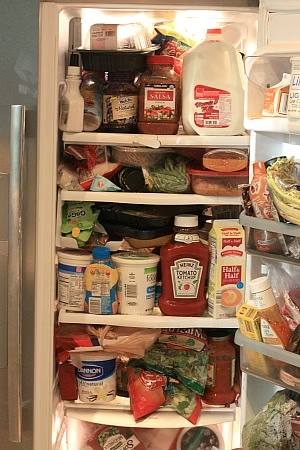
When I hit the campground in my RV, food usually takes center stage – but not just any food, a whole lot of it. As home, my meals are purely utilitarian. There’s not enough time to prepare what I can when camping. I find that I become a culinary enthusiast, But, as you can imagine, cramming several days of full on meals into a small RV fridge can be a recipe for disaster.
This is before the beverages arive on the scene. Meal become more of a celebration aroudn the campfire, and this is something you have to be aware of.
RV refrigerators are not like your home fridge. They are different in several ways, lets take a minute to explore those, and give you tips for a great food experience on your next outing.
Your RV Fridge is unlike your home
Refrigerators come in to types, absorption and Compressor and there are significant differences between the two. Your particular RV may come with either, but it is far more common to have an absorption variety. They are popular for several reasons. Lets compare them quickly:
Absorption
Absorption refrigerators use a different approach to cool your food that you are used too. They rely on a small heat source to boil a liquid, that then passes through a small jet which causes rapid cooling. Making the temperature to drop below freezing. This cold liquid then passes over a plate which will cool your RV fridge.
Compressor
Compressor-based refrigerators, on the other hand, use a familiar concept to cool your food. Your home fridge has a compressor with compresses gas, which then expands through a valve to cool the surrounding air. This method is often faster and more reliable than absorption systems.
Comparison
Aborption Pros
- No moving parts, and is very reliable.
- Becuase there is no motor, it is silent
- Easy to repair
- Works without large battery or Shore Power
- Light weight
Absorption Cons
- Slower cooling times, you must precool the refrigerator for 24 hours before filling it.
- Limited cooling capacity, food needs to be cold when put into refrigerator
- Require airspace between food
- Often do not have a defrost cycle.
Compressor Pros
- Cooling is faster
- Can put warm foods into fridge
- More precise temperature control
- Can fit more food into same space
- Usually have a defrost cycle
Compressor Cons
- Compressors and fans are nosier
- Difficult to repair
- Requires a lot of electricity, and makes boondocking without large solar impossible.
- heavy due to the additional compressor motor
Set yourself up for success!
Absorption refrigerators are common in campers and RVs because they can run on multiple power sources (propane, AC electricity, or DC battery power). Unlike compressor refrigerators, they use heat to create cooling…Here’s how to ensure yours works efficiently:
Proper Installation
One hopes that the RV manufacturer installed your Refrigerator properly – but sadly, the jokes about “That must be a friday afternoon model” is all too true. There are a few things you can check to ensure the best experience possible.
- Adequate Ventilation: Leave at least 1-2 inches of space between the back of the refrigerator and the wall. Poor ventilation is the #1 cause of absorption refrigerator failures.
- Insulation: Install proper insulation around the refrigerator cabinet to prevent heat transfer from outside. Focus on:
- The area between the refrigerator and exterior walls
- Any gaps around the refrigerator compartment
- The space between the refrigerator and any adjacent cabinets
- Proper Baffling: Install cooling baffles according to manufacturer specifications to direct airflow correctly behind the refrigerator. This helps remove heat efficiently from the cooling unit. The desire is to have a little gap between the back of the fridge and the exterior wall. Also, the baffling should go up to about 2 inches below the fins that release the heat removed from the cooling unit.
- Level Positioning: Install the refrigerator as level as possible. Generally, if you feel the camper leaning – its too far. If you can stand normally, its probably fine. The absorption process relies on gravity, and operating on an angle greater than 3 degrees for extended periods can damage the cooling unit and certainly reduce cooling capacity.
- Exterior Vent Covers: Ensure exterior vent covers remain unobstructed and clean.
Optimal Operations
- Pre-cool Before Loading: Turn on your refrigerator 24 hours before your trip to allow it to reach optimal temperature before loading with food.
- Avoid Overfilling:
- Leave space between items to allow for air circulation. Packing tightly will reduce cooling ability.
- Never block the cooling fins/coils inside the refrigerator
- Maintain at least 15-20% empty space for proper air movement
- Small battery operated fans inside the chest will increase the cooling effect and are readily available online and at camping stores.
- Food Organization:
- Store items that need the most cooling (dairy, meat) at the bottom where it’s coolest
- Use shallow containers rather than deep ones to allow quicker cooling
- Place items you’ll need first near the front to minimize door-open time
- Temperature Management:
- Use a separate refrigerator thermometer to verify temperatures (ideal range: 34-38°F) – do not trust the displays, as these are often incorrectly calibrated.
- In extreme heat, blow a fan up through the outside space. The increased airflow over the outside cooling fins will improve cooling. There are clip-on fans that can assist with this. Airflow is KING when it comes to absorption refrigeration.
- Cold Food Transfer: Only transfer pre-cooled food into the refrigerator. Adding warm food makes the unit work harder.
Maintenance Best Practices
- Regular Cleaning:
- Clean the cooling coils on the back annually
- Remove dust from exterior vents quarterly or before each major trip
- Wipe down interior surfaces monthly with baking soda solution
- Check Seals: Verify door seals are intact by placing a dollar bill in the door—if it pulls out easily, the seal needs attention.
- Burner Maintenance: If operating on propane, inspect the burner assembly annually for proper flame and clean any soot buildup. A licensed propane technician should be consulted for this.
- Winter Storage: When storing for extended periods, leave the door slightly ajar to prevent mold and odors. Place baking soda inside to absorb any residual odors.
Annual Inspection: Have a qualified RV technician inspect the cooling unit annually, especially before long trips.
Troubleshooting Tips
- If cooling performance decreases, check for level placement first
- Clean exterior vents if refrigerator seems to be working harder than usual
- In extreme heat (above 90°F), place a small fan near exterior vents to improve airflow
- If you hear a gurgling sound, this may be an indication of internal blockage and the Refrigerator is telling you — start saving, you may be in need of a new cooling unit (which is cheaper than installing a new refrigerator) — if you hear this, contact an RV Technician.
- If you smell Amonia — its a gonner. This means the cooling unit has failed completely and the coolant (Amonia, Hydrogen, Water, and Sodium Chromate) have leaked out and the cooling unit must be replaced.
Final Thoughts
Absorption refrigerators offer distinct advantages for camper life: they run silently with no moving parts, operate on multiple power sources (propane, AC, or some on DC), and perform reliably for decades when properly maintained. This versatility is perfect for boondocking or campgrounds with limited hookups, giving you true off-grid freedom.
However, they do have limitations worth considering. They cool more slowly than residential compressor models, consume more energy, and perform less efficiently in hot weather or at high altitudes. Their cooling capacity is also more modest, typically maintaining temperatures 30-40°F below ambient rather than at a fixed temperature regardless of conditions. For most campers though, these trade-offs are well worth the flexibility and reliability they provide.
If you have questions about your refrigerator, just click on Contact Us below, and we’ll be happy to answer your questions and give you helpful information to make the best decision when the time comes.
Stay Where You Are, We’ll Be Right There
If you have any questions or concerns about your absorption refrigerator, or if it’s not performing as expected, please don’t hesitate to reach out to our dedicated customer support team
